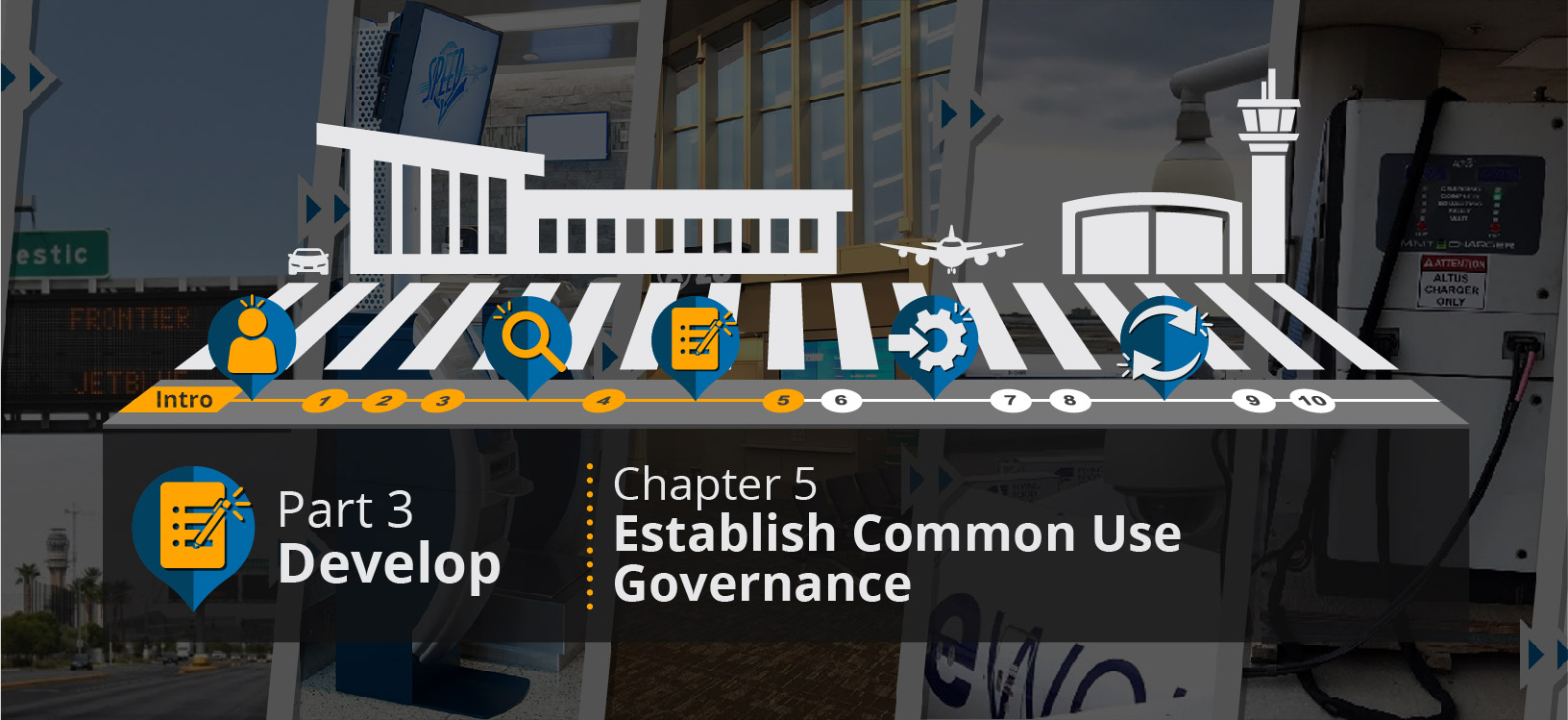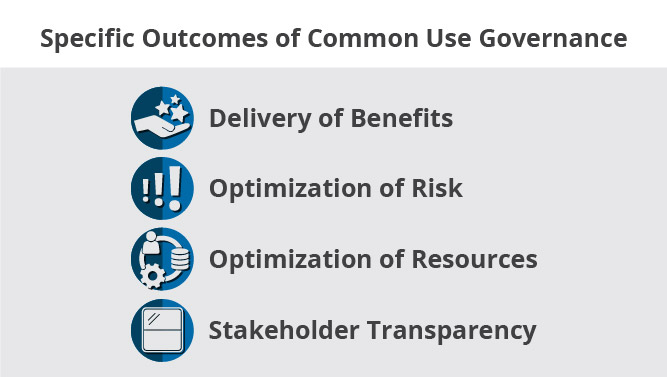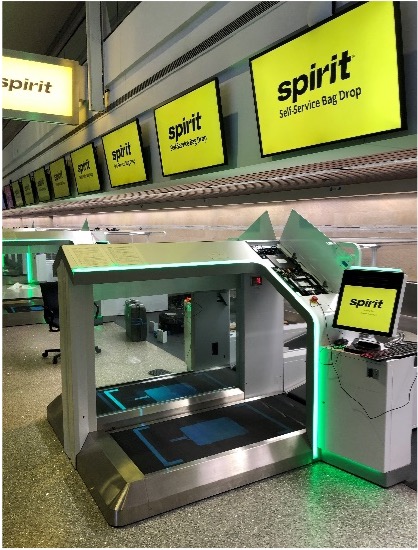


This page includes all content for this chapter.
Chapter 5: Establish Common Use Governance
Part 1 of this WebResource set the stage: having a holistic common use program is foundational to meeting the needs of customers and business partners in the modern airport environment. However, a critical but often overlooked first step in developing such a program is establishing a formal governance framework. The reason this is key to success is simple: since the move toward a more holistic approach to common use is rooted in the desire to best meet stakeholder needs, the common use program should have checks and balances to ensure any future efforts fully align with the needs of the airport and its stakeholders. A governance program provides these needed checks and balances.
This section leads you through key considerations for establishing common use governance, and it is the result of applying the research findings for this project against airport expertise and industry best practices in governance as found in COBIT 5, an ISACA Framework. For more detailed guidance on the principles and practices of governance and management, see ISACA COBIT 5, © 2012 ISACA. All rights reserved. Used with permission.
Big Picture of Common Use Governance
The ongoing governance of common use is comprised of effective principles, processes, and practices that define the authority levels and responsibilities necessary to achieve the airport's mission, vision, and objectives-all in complete alignment with the airport governance approach. Decisions related to common use should be made in accordance with the airport's strategies, objectives, and processes, overseen effectively and transparently, in compliance with legal and regulatory requirements.
This means that a governance committee should include representation from virtually all airport divisions, including executive, business development, facilities, finance administration, information technology, legal, operations, procurement, and public affairs. It may also include other external stakeholders, such as airlines, ground handlers, and/or federal agency personnel.
As you evaluate the right approach for common use governance at your airport, consider the following questions:
- Do you engage with all airport stakeholders to understand their requirements?
- Do you keep leaders informed and obtain their ongoing support, buy-in, and commitment?
- Are you guiding the processes and practices for the common use governance?
- Have you defined the information required for effective decision-making?
- Are you monitoring the effectiveness and performance of the common use governance?
- Have you assessed whether the governance system is operating effectively and provided appropriate oversight of common use?
- Does your common use governance flow from the following overarching organizational functions?
- Long-Range Planning: Greater than 5 years
- Strategic Planning: Next 5 years
- Capital Planning: Next 5 years
- Business Planning: Annually revised years 1-5
- Budgeting: Annually
Specific Outcomes of Common Use Governance
In building effective governance structures, there are four outcomes or objectives that you should seek, as shown in Figure 5.1:

Figure 5.1: Specific Outcomes of Common Use Governance
The following sections focus on these areas and provide further questions for you to consider.

Delivery of Benefits
Proper governance will maximize the value that the common use program provides to airport business functions through good business processes, effective common use services, and appropriate common use assets. It will deliver value from common use-enabled initiatives, services, and assets; cost-efficient solution and service delivery; and an accurate and reliable view of costs and benefits to effectively support the airport's business needs.
For example, the primary benefit of common use self-service kiosks is to enable passengers to move through the check-in, bag-tag, and payment remittal process quickly and efficiently. However, if the kiosks are installed in clusters without sufficient separation between groupings, that may hinder the ability of passengers to access available kiosks or even get to an open check-in or bag-drop position. It may also hinder access to the units that facilitate the needs of passengers with disabilities. Without a governance process in place to monitor key performance indicators, this condition could go unresolved for a very long time due to a lack of accountability to any specific person or group to resolve it.
Seeking such clarity in communication, Seattle-Tacoma International Airport established the following:
- A formal addendum regarding common use and resource allocation was included in the Signatory Lease and Operating Agreement (SLOA), which guided the contractual agreement between parties. This is critical for the airport to successfully implement and manage common use.
- A Common Use Facilities Advisory Committee (CUFAC) was formed by the Airline Airport Affairs Committee (AAAC) (established at the airport by the Signatory Carriers), Airport Properties, and Operations to collaborate and determine resource allocation on a monthly basis.
- A Common Use Deployment Agreement (CUDA) document was developed to outline the various stages of common use equipment deployment over time and across the airport campus.
Consider the following questions as you seek to develop or improve your common use governance approach:
- Do you regularly evaluate the common use-enabled services and assets to determine to what extent they are achieving airport objectives and delivering value?
- Do you use value management principles and practices to identify value created from common use-enabled investments throughout their full life cycle?
- Do you monitor the key metrics and goals to identify whether the business is generating the expected value and benefits for the airport from common use-enabled investments and services?

Optimization of Risk
Because the airport expects a certain value to come through the common use program, it is important to identify risks to the expected value. Examples of risks include insufficient planning for growth, changes to airline business models, or inadequate investment in solution procurement-all of which can greatly impact the expected efficiency, passenger experience, flexibility, or any other value to be gained through the program. This starts with clearly defining and communicating the airport's risk appetite and tolerance and then managing the common use-related risk to ensure it does not exceed the airport's risk appetite and tolerance.
An example can be seen in the implementation of biometric identification for self-bag drop or automated boarding. In the early days of this innovation, there was plenty of risk associated with the level of adoption by airlines and passengers. Most airports exercised restraint due to their low levels of risk tolerance, but a few with the early-adopter mindset took the risk and launched significant common use biometric identification programs. This has provided the basis for other airports to make informed decisions on how to proceed in this area.
Speaking of risk, as an airport moves into a holistic common use program-doing more to provide the entire operating environment across the environs-a clear explanation of the program will have to be made with the insurers (those that have contracted to provide liability coverage to the owner/sponsor). To an insurer, the fact that the airport is playing a larger role can initially be somewhat concerning. However, with adequate explanation (which will likely involve an onsite meeting or two), the full program can usually be described, and the insurer can be brought to an adequate level of comfort. They need to understand that a well-crafted implementation does not adversely impact the overall risk profile in any significant way and that appropriate safeguards, processes, governance, and support have all been put into place.
This should not be expected to be a one-time conversation; it will likely necessitate annual updates on the program. The personnel managing the overall risk program at the airport will need to be brought into the loop regarding the planned implementation and other details, and this should be done sooner rather than later.
Consider the following questions as you seek to develop or improve your common use governance approach:
- Do you regularly evaluate the effect of risk on the current and future use of common use in the airport?
- Have you developed common use risk management practices that are appropriate to ensure that the actual common use risk does not exceed the governance risk appetite?
- Have you developed and are you monitoring key metrics and goals of the risk management processes, and do you have the means to identify, track, report, and resolve issues?
- Have you involved the risk management personnel in the discussions?

Optimization of Resources
A common use operating model relies on maintaining an appropriate level of people, processes, and technology to support airport objectives effectively. This will help to address resource needs successfully at appropriate costs.
Oftentimes, airports that are replacing an existing set of common use hardware will identify the number of workstations currently deployed and procure a one-for-one replacement without evaluating the extent to which each workstation is actually used. Optimization of resources involves monitoring the resource requirements and identifying cases in which the resources may not be needed. For example, some airlines may be using a check-in position simply for the physical space it provides for queuing and operational movement without actually needing additional workstations.
Consider the following questions as you seek to develop or improve your common use governance approach:
- Do you regularly evaluate the current and future need for common use-related resources, options for resourcing, and allocation and management practices to meet the needs of the airport stakeholders?
- Do you have resource management principles in place to maximize the value of common use resources throughout their full economic life cycle?
- Do you monitor the key metrics and goals of the resource management processes and have the means to identify, track, report, and resolve issues?

Stakeholder Transparency
Since a holistic common use program is an elevated, organization-wide initiative, it is important to ensure transparency of the associated performance measures among the stakeholders who are approving the goals and metrics and taking the necessary remedial actions. This communication must be effective and timely, focused on increasing performance, identifying areas for improvement, and ensuring that common use-related objectives and strategies are in line with the airport's strategy.
In most cases, the stakeholders that are directly involved in the common use program are internal to the airport management team. But in some cases, there are airline representatives either as part of a consortium or as individual stakeholders who are part of the communication process. It is important to note that an assumption should not be made-particularly with significant elements of the program-that the local airline station management personnel are effective communicators to and from their respective corporate offices or that they have significant decision-making authority. Local personnel should always be kept in the communication loop; however, direct lines of communication should also be firmly established with corporate offices. Where there is ever a question as to whether to communicate with corporate or local personnel, the answer should be a firm “YES!” Communicate effectively with both.
Seeking such clarity in communication, Seattle-Tacoma International Airport established the following:
- A formal addendum regarding common use and resource allocation was included in the SLOA, which guided the contractual agreement between parties. This is critical for the airport to successfully implement and manage common use.
- A CUFAC was formed by the AAAC, Airport Properties, and Operations to collaborate and determine resource allocation on a monthly basis.
- A CUDA document was developed to outline the various stages of common use equipment deployment over time and across the airport campus.
Consider the following questions as you seek to develop or improve your common use governance approach:
- Do you regularly evaluate the current and future requirements for stakeholder communication and reporting?
- Have you established effective stakeholder communication and reporting that provides complete and high-quality information, an oversight process for mandatory reporting, and a communication strategy for stakeholders?
- Do you monitor the effectiveness of stakeholder communication and assess for accuracy, reliability, and effectiveness, and determine if the requirements of different stakeholders' groups are met?
As previously noted, the purpose of governance is to ensure that the needs of the airport and its external stakeholders are being met. What has been presented here is merely a general framework, which should be adapted as appropriate to fit your specific program. For some airports, there may be a formal governance committee already in place championed by the Operations, IT, or even Business Development functions. But for some, this may start off as a single individual with a holistic vision who takes on the challenge of creating a structure that can grow over time as more internal stakeholders are brought on board. The strategic elements described in the next chapter will certainly create that opportunity to engage more stakeholders. For more detailed guidance on the principles and practices of governance and management, see ISACA COBIT 5, © 2012 ISACA. All rights reserved. Used with permission.



